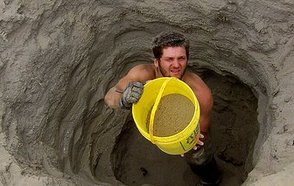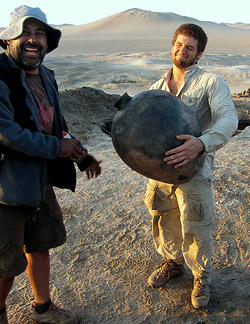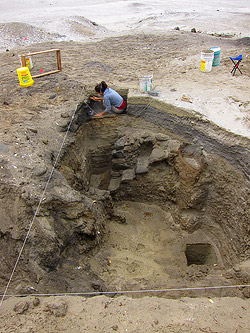Michael A. Paniccia '14

September 22, 2011

Sophomore Michael A. Paniccia straddled the line between vacation and school this summer. The Michigan City, Ind., native spent July on the southern coast of Peru, excavating centuries-old ruins buried beneath meters of dirt and sand.
At one time ruled by the Inca, Peru has a rich archaeological history, including the Nazca Lines – giant ground-etched drawings fully visible only from the air – and Macchu Pichu. But Paniccia passed over these main attractions to work in the Paracas National Reserve, a national park home to sea lions, flamingos, Humboldt penguins and its own archaeological treasures, from pre-Inca societies to Colonial-era ruins.
During his 37-day excursion, the group he worked with stayed at a remote ranger station in the park, located on a cliff overlooking a lagoon on the Pacific coast. The group rose with the sun every morning and traveled 45 minutes via off-road trails to the excavation site, an area next to a small bay that has been occupied by numerous peoples. Though they worked in a desert not far from the Equator, the southern hemisphere’s flipped calendar spared Paniccia and the others from stifling heat.
“It was absolutely beautiful,” Paniccia says. “It never rained; but most days were overcast, and in the morning we would sometimes get a salt mist from low-lying clouds that soaked everything. It’s a whole new world there.”
 Paniccia worked with Jalh Dulanto, a professor of archaeology at Pontificia Universidad Católica del Perú. The two met last year, when Dulanto was visiting professor of anthropology at DePauw and Paniccia was a student in his Human Origins course. They were joined by two of Dulanto’s Peruvian students and an archaeological anthropologist from Penn State University.
Paniccia worked with Jalh Dulanto, a professor of archaeology at Pontificia Universidad Católica del Perú. The two met last year, when Dulanto was visiting professor of anthropology at DePauw and Paniccia was a student in his Human Origins course. They were joined by two of Dulanto’s Peruvian students and an archaeological anthropologist from Penn State University.
“It was a great experience,” Paniccia says. “I feel like I couldn’t have gotten a better chance to try out all the different kinds of field equipment, types of excavations and individual instruction than I did there. I’m glad I went with a professor, rather than a commercial field school.”
The crew mixed modern GPS equipment, ground-penetrating radar (GPR) surveys and photogrammetry – 3D modeling through photographs – with traditional field techniques to document the area as they uncovered the history below.
“I actually received the privilege to use a lot of the equipment, or at least help out and watch closely as one of the professors worked,” Paniccia says. “I don’t think many people can say that they’ve used a GPR before – especially as a college freshman.” On his journey back home from Paracas, Paniccia spent a day in Lima before taking a red-eye flight back to Chicago. Besides the usual sites and museums, such as the San Franciscan convent in the heart of the city and the natural history museum, Paniccia visited the National Museum of the Archaeology, Anthropology and History of Peru in the Pueblo Libre district. Only then did the impact of his fieldwork hit him.
On his journey back home from Paracas, Paniccia spent a day in Lima before taking a red-eye flight back to Chicago. Besides the usual sites and museums, such as the San Franciscan convent in the heart of the city and the natural history museum, Paniccia visited the National Museum of the Archaeology, Anthropology and History of Peru in the Pueblo Libre district. Only then did the impact of his fieldwork hit him.
“The museum there had a huge collection from the area where we had been digging,” Paniccia says. “One of the exhibits was actually a replica of a burial chamber nearly identical to the one I had helped excavate only a few days before. It was really breathtaking for me. I actually sat down for a few minutes just laughing to myself, amazed at seeing all of the hard work I had done over the past month come together in front of my eyes. The exhibit made me want to get in my taxi and go straight back to work.”
He will – and soon. Paniccia will return to Peru during DePauw’s Winter Term to work with Dulanto again, this time in a different area of the same park.
“Even after just a day or two of class, I already felt ready to go back to work in the field,” Paniccia says. “I think I’m more excited this time than I was last time I went.”